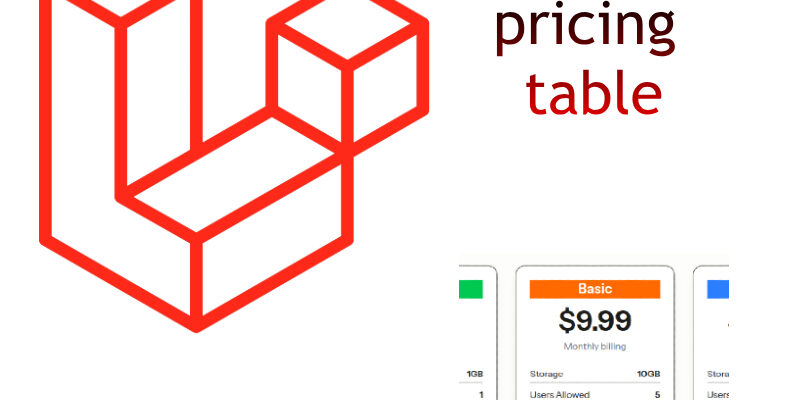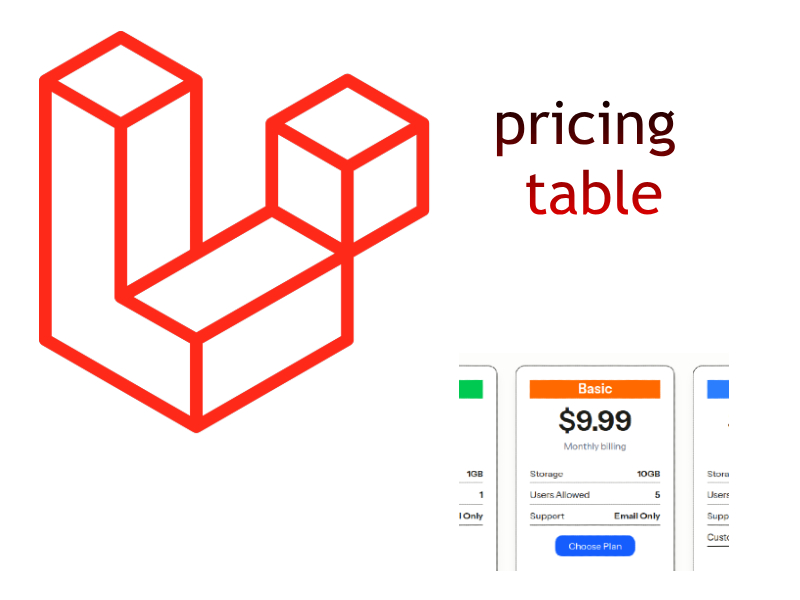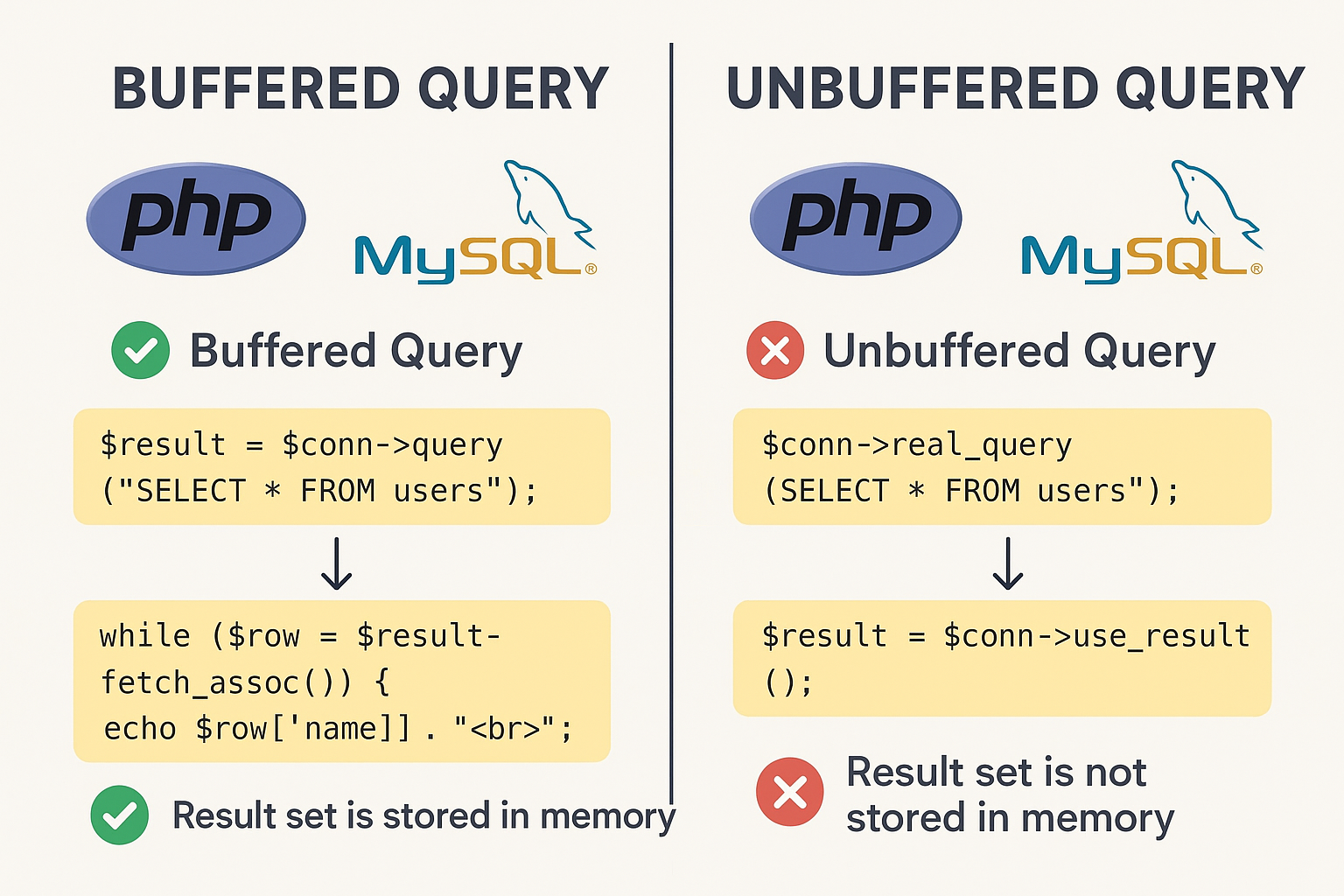
Pricing systems are a common requirement for SaaS platforms and subscription-based products. In this tutorial we will implement a dynamic pricing system in your laravel project.
Many today web applications especially Sass-based applications have a pricing feature so that users can subscribe to in order to use the website features. To do so websites usually have a pricing page that contain a table list of packages or plans starting from the free plan to paid plans.
In this article we’ll walk through how to build a dynamic pricing system using Laravel, complete with database structure, models, controllers, and a front-end pricing table.
Step 1: Database Design
We’ll use three main tables:
- plans: stores plan details (e.g., name, price, billing cycle)
- features: lists all possible features (e.g., “Storage”, “Support”, etc)
- plan_features: defines which features belong to which plan.
┌──────────────────────┐ ┌──────────────────────┐
│ plans │ │ features │
├──────────────────────┤ ├──────────────────────┤
│ id (PK) │ │ id (PK) │
│ name │ │ name │
│ slug │ │ created_at │
│ price │ │ updated_at │
│ billing_cycle │ └──────────────────────┘
│ description │
│ created_at │
│ updated_at │
└─────────┬────────────┘
│ 1 N
│
│
┌─────────▼────────────┐
│ plan_features │
├───────────────────────┤
│ id (PK) │
│ plan_id (FK → plans) │
│ feature_id (FK → features) │
│ value (feature detail)│
│ created_at │
│ updated_at │
└───────────────────────┘
Step 2: Models and Migrations
Create the table migrations and models with artisan:
php artisan make:model Plan -m php artisan make:model Feature -m php artisan make:migration create_plan_features_table
Run these commands in order, it will create the models and migrations for the previous tables (plans, features and plan_features).
Open each migration and populate with the below code:
__create_plans_table.php
return new class extends Migration
{
/**
* Run the migrations.
*/
public function up(): void
{
Schema::create('plans', function (Blueprint $table) {
$table->id();
$table->string('name');
$table->string('slug')->unique();
$table->decimal('price', 10, 2)->default(0);
$table->enum('billing_cycle', ['monthly', 'yearly'])->default('monthly');
$table->string('description')->nullable();
$table->timestamps();
});
}
/**
* Reverse the migrations.
*/
public function down(): void
{
Schema::dropIfExists('plans');
}
};
__create_features_table.php
return new class extends Migration
{
/**
* Run the migrations.
*/
public function up(): void
{
Schema::create('features', function (Blueprint $table) {
$table->id();
$table->string('name');
$table->timestamps();
});
}
/**
* Reverse the migrations.
*/
public function down(): void
{
Schema::dropIfExists('features');
}
};
__create_plan_features_table.php
return new class extends Migration
{
/**
* Run the migrations.
*/
public function up(): void
{
Schema::create('plan_features', function (Blueprint $table) {
$table->id();
$table->foreignId('plan_id')->constrained('plans')->cascadeOnDelete();
$table->foreignId('feature_id')->constrained('features')->cascadeOnDelete();
$table->string('value')->nullable();
$table->timestamps();
// Prevent deuplicates
$table->unique(['plan_id', 'feature_id']);
});
}
/**
* Reverse the migrations.
*/
public function down(): void
{
Schema::dropIfExists('plan_features');
}
};
Before migration open .env and change DB_CONNECTION=mysql:
.env
DB_CONNECTION=mysql DB_HOST=127.0.0.1 DB_PORT=3306 DB_DATABASE=dynamic_pricing_system_laravel DB_USERNAME=<db-user> DB_PASSWORD=<db-password>
Next run the migrate artisan command:
php artisan migrate
Open the app/Models/Plan.php model and update like so:
<?php
namespace App\Models;
use Illuminate\Database\Eloquent\Model;
class Plan extends Model
{
protected $fillable = ['name', 'slug', 'price', 'billing_cycle', 'description'];
public function features()
{
return $this->belongsToMany(Feature::class, 'plan_features')
->withPivot(['value'])
->withTimestamps();
}
}
For mass assignment, i added the $fillable property and the features() relationship.
Let’s do the same for app/Models/Feature.php:
<?php
namespace App\Models;
use Illuminate\Database\Eloquent\Model;
class Feature extends Model
{
protected $fillable = ['name'];
public function plans()
{
return $this->belongsToMany(Plan::class, 'plan_features')
->withPivot(['value'])
->withTimestamps();
}
}
Step 3: Seeding the Data
Create a custom seeder to insert some pricing data:
php artisan make:seeder PricingSeeder
database/seeders/PricingSeeder.php
<?php
namespace Database\Seeders;
use App\Models\Feature;
use App\Models\Plan;
use Illuminate\Database\Seeder;
class PricingSeeder extends Seeder
{
/**
* Run the database seeds.
*/
public function run(): void
{
$features = [
'Storage',
'Users Allowed',
'Support',
'Custom Domain'
];
foreach ($features as $name) {
Feature::create(['name' => $name]);
}
$plans = [
[
'name' => 'Free',
'slug' => 'free',
'price' => 0.00,
'billing_cycle' => 'monthly',
'features' => [
'Storage' => '1GB',
'Users Allowed' => '1',
'Support' => 'Email Only'
]
],
[
'name' => 'Basic',
'slug' => 'basic',
'price' => 9.99,
'billing_cycle' => 'monthly',
'features' => [
'Storage' => '10GB',
'Users Allowed' => '5',
'Support' => 'Email Only'
]
],
[
'name' => 'Pro',
'slug' => 'pro',
'price' => 29.99,
'billing_cycle' => 'monthly',
'features' => [
'Storage' => '100GB',
'Users Allowed' => '10',
'Support' => 'Email & Chat',
'Custom Domain' => 'Yes'
]
],
];
foreach ($plans as $planData) {
$plan = Plan::create([
'name' => $planData['name'],
'slug' => $planData['slug'],
'price' => $planData['price'],
'billing_cycle' => $planData['billing_cycle']
]);
foreach ($planData['features'] as $featureName => $value) {
$feature = Feature::where('name', $featureName)->first();
$plan->features()->attach($feature->id, ['value' => $value]);
}
}
}
}
Run the seeder:
Step 4: Display Pricing In The UI
First create the pricing controller:
php artisan make:controller PricingController
app/Http/Controllers/PricingController.php
<?php
namespace App\Http\Controllers;
use App\Models\Plan;
use Illuminate\Http\Request;
class PricingController extends Controller
{
public function index()
{
$plans = Plan::with('features')->get();
return view('pricing.index', compact('plans'));
}
}
Register the route:
In the next part we will add a simple dashboard to manage plans, you can skip this or continue to part 2




